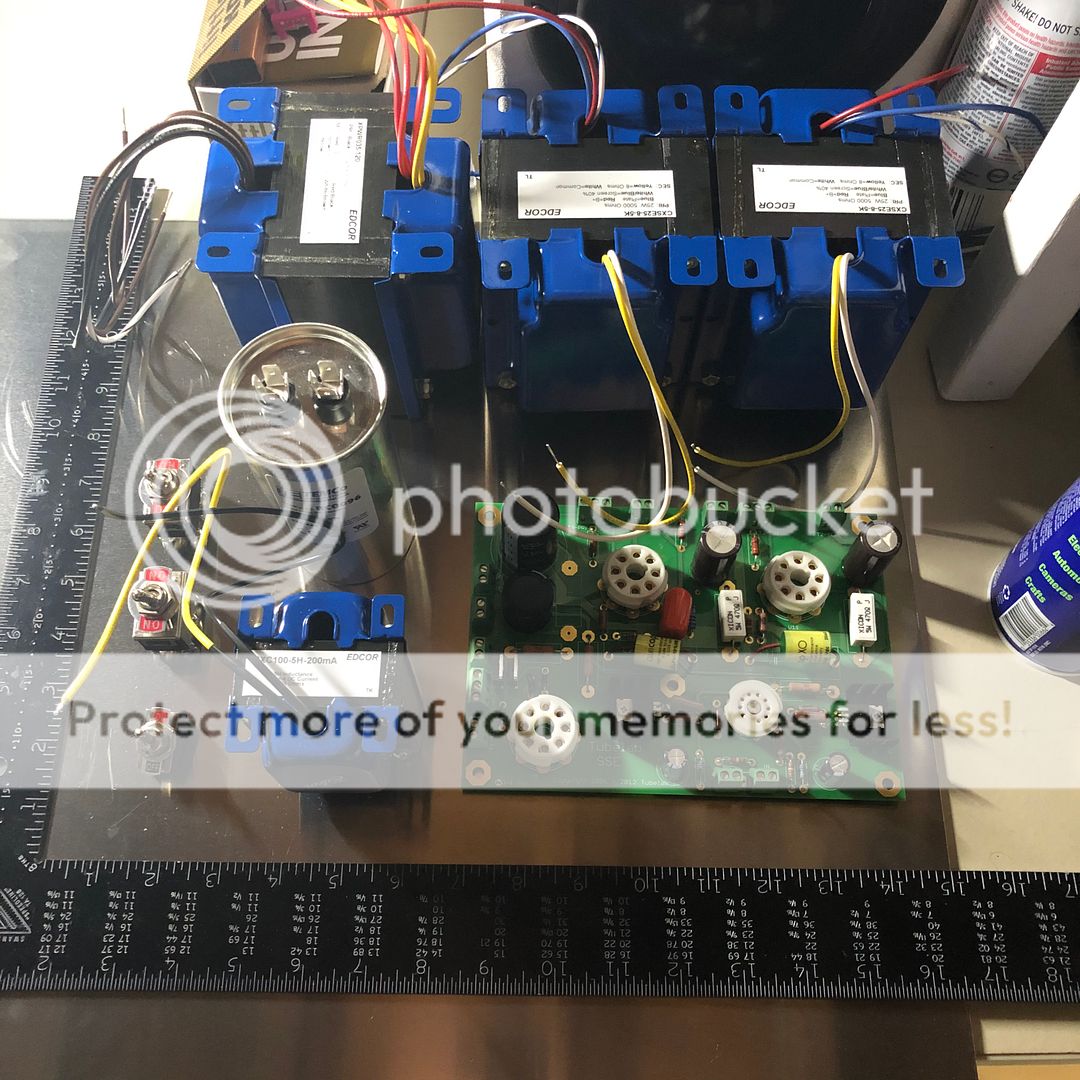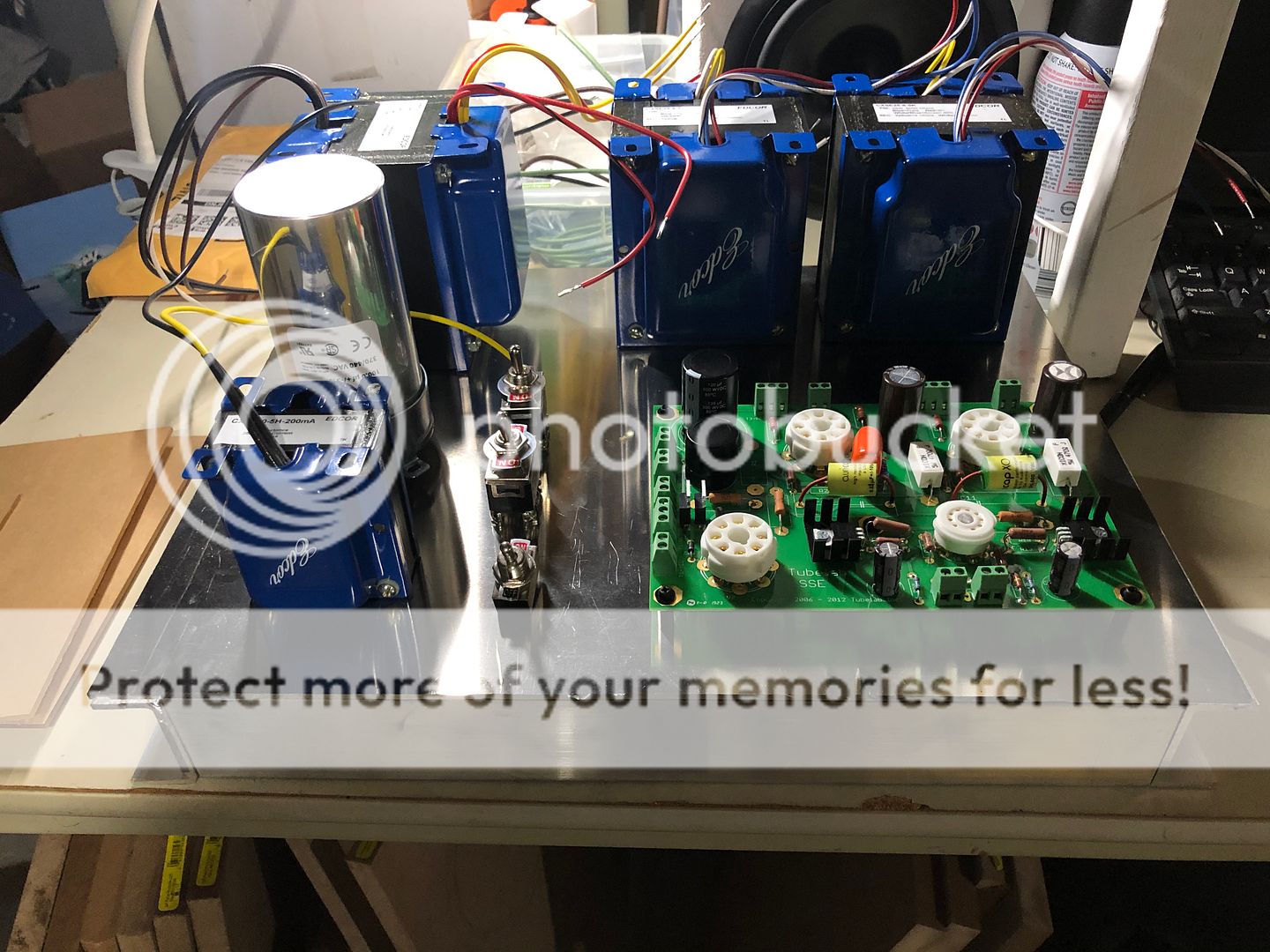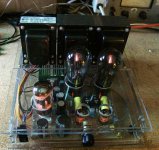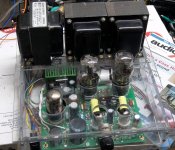Got my transformers today, trying to figure out the best way to go about laying out the top plate. I’m assuming the power and output transformers should be perpendicular. Is it ok to have them right next to each other it should three be some daylight between each transformer? Any other tips or tricks I should know about?


I’m assuming the power and output transformers should be perpendicular.
Yes.
Is it ok to have them right next to each other it should three be some daylight between each transformer?
You should give the power trans some room, as it will get warm. At least 1/2" per side minimum.
I gotta ask why you mounted everything on the top side of your PCB?
jeff
Yes.
You should give the power trans some room, as it will get warm. At least 1/2" per side minimum.
I gotta ask why you mounted everything on the top side of your PCB?
jeff
Mostly for ease of assembly, this is the first amp I’ve ever built. I also like seeing all the stuff. I plan to mount it to the aluminum top plate and then build a little vented plexiglass box to go over it.
So I have to disagree with Cogitech on this one. I think some space (1/4") between the transformers it good, give it the most you can but 1/2" is more than enough. The layout you have is pretty common and I have used it with great success on an SSE.
Not sure where we disagreed. All I did was recommend an authoritative book on the subject and recommend against the spacing in the photo.
Not sure where we disagreed. All I did was recommend an authoritative book on the subject and recommend against the spacing in the photo.
I have not read in detail but given the layout of the connectors on the PCB isn’t this the layout that makes the most sense? Putting the power transformer in the middle would require crossing of wires. Or maybe that’s not such a big deal?
The issue isn't layout, it is proximity.
Got it thanks, I’ll probably shoot to make the amp 17” wide and get some daylight between the two output transformers and as much as possible for the power.
Mr. Jones settled on 35mm as a good distance between the OPTs, to prevent the possibility of crosstalk. The orientation of your cores are correct, however.
The power transformer should be located as far as reasonably possible from the OPTs, input and output tubes - and oriented in the way yours is in the photo (90 degrees to the OPTs). Even if placed a good 8 or 9 centimeters from the closest OPT, the null line (center) of the power transformer should be aligned precisely with the OPT core.
It should be noted that I have seen all kinds of amps that do not include these principles in their design and I suspect they work just fine. I read Mr. Jones' book (more or less) and decided to pay close attention to these and other layout principles. I do not regret doing so, but my amplifier its quite large compared to some I have seen and I can understand why some people need/want to build a more compact amp.
It’s not a good idea to direct even the small leakage flux of an output transformer towards output valves, so most manufacturers bring the primary and secondary wires out on opposite sides of the core, enabling more direct wiring when the coil axis is in the preferred orientation. Although aligning coil axes parallel to the rear edge of the chassis is best, and allows the secondary tails to drop through the chassis directly above the loudspeaker terminals, it has the disadvantage of aligning the two transformer coils, potentially allowing coupling that would degrade stereo crosstalk. Later considerations resulted in a 35 mm gap between the two output transformers that should render this problem negligible.
The power transformer should be located as far as reasonably possible from the OPTs, input and output tubes - and oriented in the way yours is in the photo (90 degrees to the OPTs). Even if placed a good 8 or 9 centimeters from the closest OPT, the null line (center) of the power transformer should be aligned precisely with the OPT core.
It should be noted that I have seen all kinds of amps that do not include these principles in their design and I suspect they work just fine. I read Mr. Jones' book (more or less) and decided to pay close attention to these and other layout principles. I do not regret doing so, but my amplifier its quite large compared to some I have seen and I can understand why some people need/want to build a more compact amp.
Last edited:
I've never been able to get audio transformers and power transformers to cross talk or couple into each other that I could detect.
If you have the room to follow the general guidelines for spacing and orientation then I would do that, but if your chassis is small and it is not possible or convenient, then I would just do what you have to do and not worry much about it. It will likely be OK.
The consequences of violating a lot of things in audio are over exaggerated.
If you have the room to follow the general guidelines for spacing and orientation then I would do that, but if your chassis is small and it is not possible or convenient, then I would just do what you have to do and not worry much about it. It will likely be OK.
The consequences of violating a lot of things in audio are over exaggerated.
I've never been able to get audio transformers and power transformers to cross talk or couple into each other that I could detect.
If you have the room to follow the general guidelines for spacing and orientation then I would do that, but if your chassis is small and it is not possible or convenient, then I would just do what you have to do and not worry much about it. It will likely be OK.
The consequences of violating a lot of things in audio are over exaggerated.
Here is a picture of my Lexan TSE as it was originally built in 2004. Playing all 2 WPC through 88 dB Yamaha NS-10's didn't reveal any hum or other nasties. Note the close and cozy relationship between all the transformers and the general crowded chassis. It still wears it's DIY PC board cooked up on the kitchen stove before the TSE was actually a thing. This board was called SE45-2. The SSE wasn't even a dream then.
I took it over to a friend's house who had some high efficiency Altec Santana speakers, and hum was obvious. The amp hummed through the speakers with NO TUBES in it. There is only one way this can happen. I rotated the power transformer 90 degrees, and the hum was gone.
Some time later the TSE had a date with some 106 dB sensitivity Lowther based horn speakers. Some hum was still evident so I added a choke and supplemental cap to the already crowded amp. The white cap and small choke can be seen stuffed under the OPT's in the second picture. It was taken after the amp got filled full of water during Hurricane Wilma in 2006. I simply drained the water and plugged the amp in to find that it still worked, and sounded just fine. Unfortunately the power transformer fried a few months later. Autopsy revealed it to be all rusty inside. Since I had to change the power transformer, I put a shiny new 2007 vintage TSE board in the amp. I cleaned up the old board with WD-40 and naphtha, and it still works today. It sits unused in a box full of old boards, but I can't bring myself to toss it.
The way you have the transformers laid out on your chassis looks good.
Attachments
...
Looking for suggestions on preamps particularly with small form factors and built in DAC if possible (but not a deal breaker).
I do not use a pre with my SSE, just a 10k pot that then splits the signal between the SSE and a subwoofer. While testing I did try the SSE with a AKSA Lender pre configured for 10db of gain and it worked fine but it sounds great without the pre and my DAC or phono pre drives it well. You may want to give it a go without a pre first and see what you think.
I've given your pre-amp question a bit more thought and it depends on a few factors, I suppose. A volume pot or passive pre might be enough if you have very efficient speakers and/or you run your SSE in UL mode and/or you listen at fairly low volume.
An example of how combinations of factors play out in my situation:
My speakers are about 88dB (1w/1m) efficient. If I run my SSE in triode mode, my active pre-amp needs to be set at around 14-15 on the digital dial in order to achieve "medium reasonable" volume level in the room. The "17" position is where the active pre-amplification kicks in. If I want to play on the loud side of "reasonable", I am often turning the pre-amp to around 18-20. 22 gets me "unreasonably loud" and my speakers are hitting close to their maximum excursion.
When I set the SSE in UL mode, I never need to go beyond about 14 or 15 on the pre-amp, so it is acting as an attenuator the whole time. The gain comes on way faster. A passive pre or volume pot would suffice if I ran my amp in UL all the time. I suppose this could be a workable solution - I could run in triode most of the time and then switch to UL when I want to go loud.
All this to say, with my particular speakers in my particular room I am very glad to have the extra "oomf" that the active pre offers. Beyond that, the fact that I can select from 4 inputs, change balance, and have a remote for volume control makes the pre extremely convenient. Swapping in a different power amp takes 30 seconds.
An example of how combinations of factors play out in my situation:
My speakers are about 88dB (1w/1m) efficient. If I run my SSE in triode mode, my active pre-amp needs to be set at around 14-15 on the digital dial in order to achieve "medium reasonable" volume level in the room. The "17" position is where the active pre-amplification kicks in. If I want to play on the loud side of "reasonable", I am often turning the pre-amp to around 18-20. 22 gets me "unreasonably loud" and my speakers are hitting close to their maximum excursion.
When I set the SSE in UL mode, I never need to go beyond about 14 or 15 on the pre-amp, so it is acting as an attenuator the whole time. The gain comes on way faster. A passive pre or volume pot would suffice if I ran my amp in UL all the time. I suppose this could be a workable solution - I could run in triode most of the time and then switch to UL when I want to go loud.
All this to say, with my particular speakers in my particular room I am very glad to have the extra "oomf" that the active pre offers. Beyond that, the fact that I can select from 4 inputs, change balance, and have a remote for volume control makes the pre extremely convenient. Swapping in a different power amp takes 30 seconds.
I've given your pre-amp question a bit more thought and it depends on a few factors, I suppose. A volume pot or passive pre might be enough if you have very efficient speakers and/or you run your SSE in UL mode and/or you listen at fairly low volume.
An example of how combinations of factors play out in my situation:
My speakers are about 88dB (1w/1m) efficient. If I run my SSE in triode mode, my active pre-amp needs to be set at around 14-15 on the digital dial in order to achieve "medium reasonable" volume level in the room. The "17" position is where the active pre-amplification kicks in. If I want to play on the loud side of "reasonable", I am often turning the pre-amp to around 18-20. 22 gets me "unreasonably loud" and my speakers are hitting close to their maximum excursion.
When I set the SSE in UL mode, I never need to go beyond about 14 or 15 on the pre-amp, so it is acting as an attenuator the whole time. The gain comes on way faster. A passive pre or volume pot would suffice if I ran my amp in UL all the time. I suppose this could be a workable solution - I could run in triode most of the time and then switch to UL when I want to go loud.
All this to say, with my particular speakers in my particular room I am very glad to have the extra "oomf" that the active pre offers. Beyond that, the fact that I can select from 4 inputs, change balance, and have a remote for volume control makes the pre extremely convenient. Swapping in a different power amp takes 30 seconds.
This all makes sense, I am currently using very efficient full range drivers and dual subs using miniDSP for the crossover and EQ. My active preamp (Emotiva PT-100) does what I need it to do although I can’t find anywhere in the specs how much gain it adds. I’ve used passive preamps before but run out of headroom but that’s when I had less efficient speakers so maybe it would work now.
Just out of curiosity what is your preamp?
- Home
- More Vendors...
- Tubelab
- Birk's SSE Build Thread


